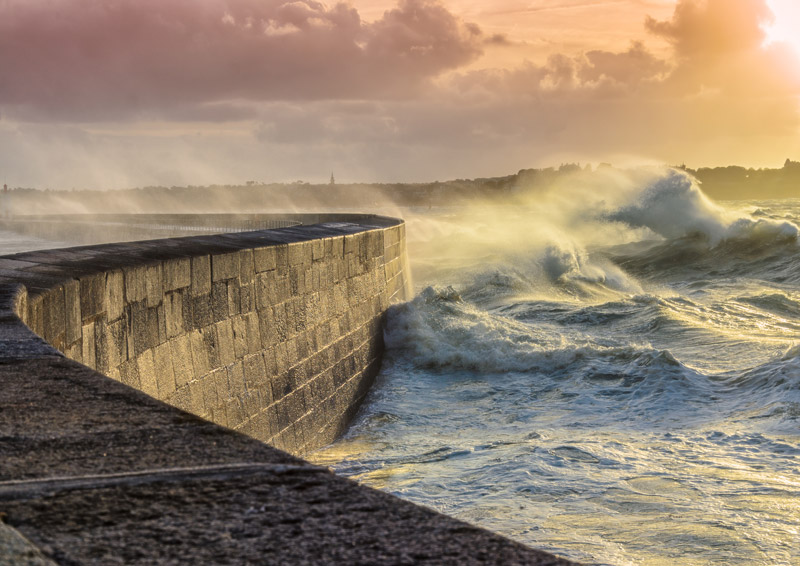Do we still expect sufficient protection against the storms and what are the solutions going forward? Marisa Ackhurst, author of Design of Vertical Gravity Sea and Quay Walls, on climate change, sea level rise, sea wall structures and more.

- Updated: 01 Jul 2020
- Author: Marisa Ackhurst, Professional Engineering Technologist
Climate change, global sea level rise, increased storminess. These ‘predictions’ of scientists are becoming a reality for all of us. More than 35% of the global population live in the coastal region and as such, the impact of ocean forces are becoming more of a concern. Just watching the news coverage of storms around the globe, we can see how some sea defences are failing to provide the expected level of protection to the public and infrastructure.
A few decades ago engineering codes did not even mention sea level rise. Or, if it was stated, there was great uncertainty around how much to allow for. ‘How much’ is still a topic of debate, but these days we do have more references to rely on. Your 1:100 design storm condition from a few decades ago has changed. While it is unfair to expect sea defences to protect us against any storm that comes our way, we do still expect sufficient protection against the ‘design’ storm.
Along with the climate change problem comes the green solution. Research is being conducted on using a range of nature-based solutions to protect our coastlines. One such example is the use of mangrove forests. The mangroves naturally trap sediments helping to stabilise the coastline, preventing erosion from waves. The difficulty for engineers at this stage is to put numbers to these solutions, which I’m sure is a problem that will be overcome in the future.
Another potential solution is the construction of artificial reefs offshore. Hard surfaces are created to which algae and invertebrates can attach. These structures can be constructed using, for example, submerged rock berms, concrete units, or even sunken ships. The raised level of the ‘seabed’ induces some of the incoming waves to break, providing protection to the coastline.
As with many things in life there is not a ‘one-size-fits-all’ solution for sea defence structures. Each project and location is different. Whatever the future holds we will still need to assess the suitability of a range of structures as possible solutions before focussing on the optimal one. Different role players have different requirements and legislation will keep on changing.
We all have a responsibility to consider greener solutions. In some instances, the solution may be to retreat, giving the coastline back to nature. In other instances, this may not be possible and our fight with the sea will continue to protect existing infrastructure, especially in built-up areas with established infrastructure. This is where vertical structures will stay relevant. Coastlines are dynamic in nature, even with the changes we make to them. We have reclaimed land and moved coastlines seaward to provide more space for our cities. We enjoy living near the sea - with some older residential developments positioned closer to the sea than they should be. This also applies to industrial and transport infrastructure.
On greenfield sites we may have a larger range of suitable ‘green’ solutions as options. When it comes to built-up and established cities and infrastructure on the coastline, traditional vertical structures may still be the best solution. Existing seawall structures are often adapted to accommodate the effects of global warming. One such example is the Dawlish sea wall in England. The wall, which provides protection to a railway line, was severely damaged in a storm resulting in damage to the railway line and other infrastructure. A new vertical concrete sea wall was constructed in front of the existing wall. The level of the wall was raised and the wall is fitted with a wave return coping structure. Moving all the existing infrastructure landwards to accommodate a softer solution would not have been the answer in this case. This is often the reality. This project also demonstrates how an existing seawall structure can be redesigned and re-constructed in almost the same location without surrendering infrastructure and property.
There are developments into making traditional concrete sea walls more environmentally friendly. Vertical concrete sea walls can be fitted with ecological enhancement features, such as textured panels, that encourage the growth of marine organisms, depending on where they are located. Research into modifying the concrete composition to reduce its carbon footprint is ongoing.
Natural solutions may also compliment the more traditional structures. They may be just what is needed to lengthen the life of older structures when used in combination.
Thus, I think vertical seawall structures will still be relevant for a long time, possibly developing in greener solutions.
Our guide, Design of Vertical Gravity Sea and Quay Walls, covers everything you need to know about the design of vertical gravity concrete sea and quay wall structures! Get your copy to learn more - available in print and as an eBook.
